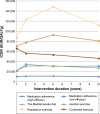Type 2 diabetes: cost-effectiveness of medication adherence and lifestyle interventions
- PMID: 27757024
- PMCID: PMC5055046
- DOI: 10.2147/PPA.S114602
Type 2 diabetes: cost-effectiveness of medication adherence and lifestyle interventions
Abstract
Introduction: Type 2 diabetes is a major burden for the payer, however, with proper medication adherence, diet and exercise regime, complication occurrence rates, and consequently costs can be altered.
Aims: The aim of this study was to conduct a cost-effectiveness analysis on real patient data and evaluate which medication adherence or lifestyle intervention is less cost demanding for the payer.
Methods: Medline was searched systematically for published type 2 diabetes interventions regarding medication adherence and lifestyle in order to determine their efficacies, that were then used in the cost-effectiveness analysis. For cost-effectiveness analysis-required disease progression simulation, United Kingdom Prospective Diabetes Study Outcomes model 2.0 and Slovenian type 2 diabetes patient cohort were used. The intervention duration was set to 1, 2, 5, and 10 years. Complications and drug costs in euro (EUR) were based on previously published type 2 diabetes costs from the Health Care payer perspective in Slovenia.
Results: Literature search proved the following interventions to be effective in type 2 diabetes patients: medication adherence, the Mediterranean diet, aerobic, resistance, and combined exercise. The long-term simulation resulted in no payer net savings. The model predicted following quality-adjusted life-years (QALY) gained and incremental costs for QALY gained (EUR/QALYg) after 10 years of intervention: high-efficacy medication adherence (0.245 QALY; 9,984 EUR/QALYg), combined exercise (0.119 QALY; 46,411 EUR/QALYg), low-efficacy medication adherence (0.075 QALY; 30,967 EUR/QALYg), aerobic exercise (0.069 QALY; 80,798 EUR/QALYg), the Mediterranean diet (0.057 QALY; 27,246 EUR/QALYg), and resistance exercise (0.050 QALY; 111,847 EUR/QALYg).
Conclusion: The results suggest that medication adherence intervention is, regarding cost-effectiveness, superior to diet and exercise interventions from the payer perspective. However, the latter could also be utilized by patients without additional costs, but medication adherence intervention requires trained personnel because of its complex structure. Interventions should be performed for >2 years to produce noticeable health/cost results.
Keywords: adherence; cost-effectiveness; intervention; lifestyle; medication; type 2 diabetes.
Conflict of interest statement
The authors report no conflicts of interest in this work.
Figures
Similar articles
-
Clinical outcomes and cost-effectiveness of strategies for managing people at high risk for diabetes.Ann Intern Med. 2005 Aug 16;143(4):251-64. doi: 10.7326/0003-4819-143-4-200508160-00006. Ann Intern Med. 2005. PMID: 16103469
-
Economic analysis of the implementation of guidelines for type 2 diabetes control developed by Diabetes Poland: what increase in costs is justified by clinical results?Pol Arch Med Wewn. 2011 Oct;121(10):345-50. Pol Arch Med Wewn. 2011. PMID: 22045095
-
The clinical and economic burden of poor adherence and persistence with osteoporosis medications in Ireland.Value Health. 2012 Jul-Aug;15(5):604-12. doi: 10.1016/j.jval.2012.02.001. Epub 2012 Apr 11. Value Health. 2012. PMID: 22867768
-
The modeled lifetime cost-effectiveness of published adherence-improving interventions for antihypertensive and lipid-lowering medications.Value Health. 2010 Sep-Oct;13(6):685-94. doi: 10.1111/j.1524-4733.2010.00774.x. Value Health. 2010. PMID: 20825627 Review.
-
Incremental cost-effectiveness of evidence-based non-surgical weight loss strategies.Clin Obes. 2019 Apr;9(2):e12294. doi: 10.1111/cob.12294. Epub 2019 Jan 24. Clin Obes. 2019. PMID: 30677252
Cited by
-
Prevalence and Clinical Significance of Occult Pulmonary Infection in Elderly Patients with Type 2 Diabetes Mellitus.Biomed Res Int. 2021 Dec 2;2021:3187388. doi: 10.1155/2021/3187388. eCollection 2021. Biomed Res Int. 2021. PMID: 34901268 Free PMC article.
-
Potential Effectiveness of Registered Dietitian Nutritionists in Healthy Behavior Interventions for Managing Type 2 Diabetes in Older Adults: A Systematic Review.Front Nutr. 2022 Jan 24;8:737410. doi: 10.3389/fnut.2021.737410. eCollection 2021. Front Nutr. 2022. PMID: 35141261 Free PMC article.
-
The Relationship between Health Literacy and Health Promoting Behaviors in Patients with Type 2 Diabetes.Int J Community Based Nurs Midwifery. 2018 Jan;6(1):65-75. Int J Community Based Nurs Midwifery. 2018. PMID: 29344537 Free PMC article.
-
Cost-Effectiveness of Point-of-Care A1C Tests in a Primary Care Setting.Front Pharmacol. 2021 Jan 19;11:588309. doi: 10.3389/fphar.2020.588309. eCollection 2020. Front Pharmacol. 2021. PMID: 33542687 Free PMC article.
-
Relationship between ego depletion and health promotion behaviors in older adults with diabetes: A cross-sectional study in Shanghai, China.Glob Health Med. 2025 Feb 28;7(1):57-63. doi: 10.35772/ghm.2024.01090. Glob Health Med. 2025. PMID: 40026856 Free PMC article.
References
-
- Slovenian National Institute of Public Health Drug consume database from 2001 to 2014. [Accessed December 1, 2015]. Available from: https://partner.zzzs.si/wps/wcm/connect/94bb0e3f-3d23-4156-926f-47732415....
-
- Shaw JE, Sicree RA, Zimmet PZ. Global estimates of the prevalence of diabetes for 2010 and 2030. Diabetes Res Clin Pract. 2010;87:4–14. - PubMed
-
- Zhang P, Zhang X, Brown J, et al. Global healthcare expenditure on diabetes for 2010 and 2030. Diabetes Res Clin Pract. 2010;87:293–301. - PubMed
-
- Tandon N, Ali MK, Narayan KM. Pharmacologic prevention of microvascular and macrovascular complications in diabetes mellitus: implications of the results of recent clinical trials in type 2 diabetes. Am J Cardiovasc Drugs. 2012;12:7–22. - PubMed
LinkOut - more resources
Full Text Sources
Other Literature Sources



